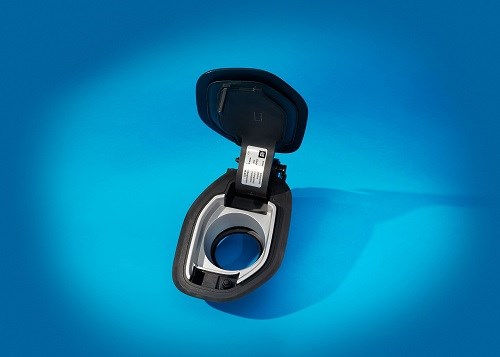Body Exterior Finalists of SPE Auto Innovation Awards
Exterior applications meriting mention from the 2015 SPE Auto Innovation Awards include entrants from Ford and GM.
Exterior applications meriting mention from the 2015 SPE Auto Innovation Awards include entrants from Ford and GM.
As a continuation of a series of blogs that I have posted in the last couple of months on finalists of the 2015 SPE Automotive Innovation Awards, here is one on two interesting body exterior applications that captured the judges’ attention.
• Charge Port Bezel: This injection-molded charge port bezel, which is located very precisely with no gaps or movement normally associated with typical cantilevered snap-fit components, is featured on GM’s 2016 Chevrolet Volt BEV. This patented GM innovation utilizes the natural elastic properties of the material to create engineered interferences within a part design. The technology significantly over-constrains mating components with a large number of relatively compliant members.

As the system is preloaded, the elastic properties of the material allow for the size and position error of each individual contact feature to be averaged out over the sum of contact features throughout the solid body. This provides precision alignment while eliminating part-to-part relative motion.
The component utilizes molded-in color, electrically-conductive MetalLX Hostaform POM acetal copolymer from Celanese, Irving, Texas, which provides the appearance of chrome without the cost of environmental concerns. This application was the first within GM to provide retaining elastic averaging features. The engineered interference of the tubes to the female receptacles provide a “spring force” against the retaining features which hold the retention features in a positive engagement throughout the life of the parts.
Compared to the previous design, adding elastic averaging features to the charge port bezel and housing eliminated looseness and noise issues as well as part float from locating feature clearances. Increased stiffness and load capacity give the part a quality ‘solid’ feel, and created a part locating scheme, which was more robust to wear. The design helped reduce labor to install and ensure the part was centered in the charge-port opening. ITW Fuel Systems was the Tier I supplier.
• Emblem Front-Camera Deployment Mechanism: This multi-material injection molded component is featured on Ford’s 2016 Lincoln MKX CUV. This 360-degree camera system was a critical feature for this model to meet customer needs in the global premium market. With the signature Lincoln split-wing grille, it was difficult to package a front camera on the face of the 2016 MKX without blemishing the face of the vehicle with the mechanical appearance of an exposed camera.

The goal was to have a camera that is hidden and then deployed only when function is required. A front camera helps drivers see curbs while parking. Traditional deployable cameras were on the rear of vehicles and required bulky and heavy metallic housings and components. Using a similar approach on the front of the vehicle posed a problem due to lack of structure that a rear mechanism has. Mounting a mechanism on the front of a vehicle requires the lightest possible solution to avoid fascia deformation and excessive vibration under road loads. This drove the mechanism development to a nearly all-plastic design with minimized metal content.
The all-plastics mechanism for the MKX is 41% lighter than the traditional mechanisms used by VW and 55% lighter than that of BMW with no loss of function. Moreover, converting to this mechanism allowed a camera washer nozzle to be hidden so the camera is washed in its stowed position, and led to multiple patent filings.
The Tier 1 system supplier is Huf North America, Greenville, Tenn. Four major material suppliers were part of this collaborative effort for the various parts of this component. A 15% glass-filled PBT from DuPont, Wilmington, Del. is used to make the gear/PCB cover. The gears are made of a polyacetal from DuPont and a nylon 66 from BASF, Florham Park, N.J. The overmolded drive links are made of a 30% glass-filled nylon 66 from Lanxess, Pittsburgh. Finally, the camera bracket is made from 15% glass-filled acetal from Celanese, Irving, Texas.
Related Content
Scaling Up Sustainable Solutions for Fiber Reinforced Composite Materials
Oak Ridge National Laboratory's Sustainable Manufacturing Technologies Group helps industrial partners tackle the sustainability challenges presented by fiber-reinforced composite materials.
Read MoreVolume Resin Prices Move in Different Directions
PE, PP, PVC, and ABS prices slump, while PS, PET, PC, and nylons 6 and 66 prices rise.
Read MoreTracing the History of Polymeric Materials: Aliphatic Polyketone
Aliphatic polyketone is a material that gets little attention but is similar in chemistry to nylons, polyesters and acetals.
Read MoreHow Do You Like Your Acetal: Homopolymer or Copolymer?
Acetal materials have been a commercial option for more than 50 years.
Read MoreRead Next
People 4.0 – How to Get Buy-In from Your Staff for Industry 4.0 Systems
Implementing a production monitoring system as the foundation of a ‘smart factory’ is about integrating people with new technology as much as it is about integrating machines and computers. Here are tips from a company that has gone through the process.
Read MoreProcessor Turns to AI to Help Keep Machines Humming
At captive processor McConkey, a new generation of artificial intelligence models, highlighted by ChatGPT, is helping it wade through the shortage of skilled labor and keep its production lines churning out good parts.
Read MoreWhy (and What) You Need to Dry
Other than polyolefins, almost every other polymer exhibits some level of polarity and therefore can absorb a certain amount of moisture from the atmosphere. Here’s a look at some of these materials, and what needs to be done to dry them.
Read More


























